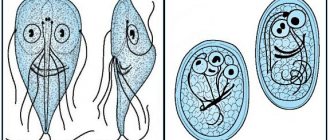In modern veterinary medicine, malignant tumors are being detected more and more often, and this is primarily due to increased diagnostic capabilities.
Among various malignant neoplasms, mastocytomas, diagnosed in domestic cats, are distinguished. These are mast cell tumors that primarily affect the skin and subcutaneous tissue.
A distinctive feature is the course of the malignant process. Mastocytoma develops more slowly in cats than in dogs and is less aggressive.
Description
Mast cells are present in all body systems, participating in inflammatory and allergic processes.
Mastocytoma is a mast cell tumor consisting of mast cells that have become malignant. Clusters of mast cells take on a granular form, releasing histamine and heparin into the body.
An increase in histamine levels in the body leads to ulceration of the gastrointestinal tract and the occurrence of allergic reactions. Histamine releases determine the behavior of the tumor, which periodically increases and decreases in size.
The cutaneous form of the disease is more common. In cats, single mastocytomas are usually found; multiple mastocytomas occur in 20% of cases.
Mastocytoma is characterized by differences in biological behavior:
- Highly differentiated tumor. Slowly growing (up to a year or more) formation, low-aggressive, well limited from surrounding tissues. Metastases occur in 10% of cases.
- Moderately differentiated formation, with a local aggressive course, metastasizes in 30% of cases.
- Poorly differentiated tumor - rapidly growing, diffuse in nature, poorly limited from surrounding tissues. Metastasizes in 55-90%. Regardless of the location of the tumor, the clinical health of the cat suffers. Gastrointestinal pathologies, anorexia, and vomiting develop.
Metastases primarily affect the lymph nodes, then the liver and spleen, and in the terminal stage the bone marrow is affected.
The disease occurs in cats over four years of age; Siamese cats are most susceptible to the pathology. Young Siamese cats sometimes develop pathology in the form of nodules and papules, which disappear on their own within two years. In Sphynx cats, sharp proliferation of mast cells into the subcutaneous tissue is possible, followed by resorption.
Most mastocytes in cats are of low grade, which increases the chances of a successful outcome of the disease.
How to recognize mastocytoma in an animal?
mastocytomas are great imitators. They can be in the form of ulcers, swellings, plaques, loose subcutaneous masses, which can lead to a false conclusion. However, making a diagnosis in most cases is not difficult. Using a fine-needle biopsy, cellular material is collected, from which a smear is then made and stained according to Pappenheim.
Obtaining material for cytological examination from an intradermal formation using fine-needle aspiration biopsy
About 90% of mastocytomas have a characteristic appearance under light microscopy. Otherwise, it is necessary to stain the biopsy material with toluidine blue, which makes it possible to differentiate granules of biologically active substances in the cytoplasm. However, tumor mastocytes without an intracellular granular component, the so-called histiocytic type of mastocytoma, are uncommon in cats. In this case, immunocytochemistry or immunohistochemistry is necessary. Also, to fully understand the biological behavior of a neoplasm in a particular animal, analysis for C-Kit and Ki-67 . These two indicators are leading for assessing the sensitivity of the tumor to chemotherapy and for prognosis of the course of the disease. Cytological analysis makes it possible to make a diagnosis quickly and cheaply, and this is its advantage. But the degree of malignancy is determined only on the basis of a pathohistological examination or biopsy material.
Cytology
Histology
In dogs, the disease always occurs in isolation, that is, each lesion is a separate tumor that grows independently of the others. In cats , one or more mastocytes are often the result of a systemic disease. But in any case, the animal undergoes a comprehensive examination.
Clinical picture of mastocytes
Clinical picture of mastocytes
Causes
The etiology of the pathology has not been fully studied. The predominance of a genetic factor in the development of the disease is assumed. Mutation of the C-Kit SCF gene leads to a change and increase in the number of mast cells.
The C-Kit gene encodes a receptor protein on the mast cell membrane. The receptor binds mast cell growth factor. Self-activation of the receptor leads to uncontrolled active cell division. This theory is confirmed by the frequent incidence of diseases in Siamese cats.
The occurrence of mastocytoma is possible against the background of chronic inflammation of the skin (contact dermatitis) and frequent allergic reactions.
Mutations of mast cells are possible under the influence of unfavorable factors or their combination. The disease can be provoked by the influence of ionizing radiation, chronic intoxication and autoimmune diseases.
The mutational nature of the pathology suggests a malignant course of the disease.
Why does the disease develop?
There are no exact reasons that underlie the development of mastocytoma. Any pet may be at risk, although brachycephalic dogs are predisposed to the disease after 8-9 years of age.
It is assumed that the causes of mastocytoma lie in the influence of environmental factors of a viral, bacterial or fungal nature. But this assumption has not been studied in any way, and therefore has no basis.
Regardless of this, veterinarians are unanimous on one thing - the development of skin cancer is promoted by mutations in the proto-oncogene gene. It takes part in blood formation and proliferation of mast cells. This fact is confirmed by the fact that the tumor is formed from mast cells.
Symptoms
The most common form of mastocytoma is cutaneous (90%). The favorite localization is the scalp and neck; lesions of the trunk and extremities are less common. A neoplasm in the form of one or several growths of brown or pink color, dense consistency. The size of the nodes is 0.2-3 cm.
There is no hair at the site of the lesion, redness and swelling are observed. Histamine releases lead to itching and allergic reactions. Sometimes the disease is asymptomatic.
If the skin form of the formation behaves aggressively, the following symptoms are observed:
- hyperemia and swelling of the tumor bed, fluctuation;
- ulceration of the affected area;
- severe pain on palpation;
- positive Darier's syndrome, with the formation of erythema and papules;
- signs of damage to the gastrointestinal tract, the development of glomerulonephritis.
Self-examination of the tumor is strictly prohibited. Deep palpation accelerates the course of the disease and can provoke the occurrence of metastases.
When mastocytoma occurs in cats in internal organs, systemic mastocytosis is characterized by the following symptoms:
- loss of appetite, weight loss;
- bloating;
- vomiting, diarrhea;
- depressed state, lethargy;
- breathing problems.
Breed predisposition
Mast cell tumor occurs with equal frequency in females and males, “loves” old dogs, from 9 years old. However, there is no guarantee that mastocytoma will not be detected in a pet until old age.
According to observations, signs of the disease are observed more often in the following breeds of dogs:
- Boxer, bulldog, pit bull terrier.
- Beagle, Shar Pei, English Setter.
- Boston Terrier, Labrador Retriever.
It is noteworthy that mastocytoma develops more often in short-haired and wire-haired breeds, possibly due to the effect of UV rays.
Treatment
Based on the examination, the stage of the disease is determined, which determines the choice of treatment tactics:
- Stage 0. Completely removed mastocytoma with favorable results of histological treatment.
- Stage I. A single neoplasm without metastases in the lymph nodes.
- Stage II. A single tumor, well circumscribed, with metastases to the lymph nodes.
- Stage III. Multiple mastocytomas.
- Stage IV. Any neoplasm with metastases in internal organs, including bone marrow.
Pre-surgical cytology is performed to identify the tumor and develop a treatment plan.
Single, well-differentiated skin mastocytomas are removed surgically. In case of a complicated diagnosis, surgery is performed in conjunction with chemotherapy or radiation. In some cases, surgical treatment is contraindicated. In advanced cases, palliative therapy is prescribed.
Surgery
Stage 0-II tumors of varying degrees of malignancy are treated surgically.
Before surgery, the cat is treated with glucocorticosteroid drugs to reduce the size of the tumor and increase the chance of completely removing the tumor.
Correct coagulopathy that may result from the release of heparin from mast cells.
Surgical intervention involves excision of the tumor, including three centimeters of border areas of healthy skin. Cells from the tumor and border areas are sent for histological examination.
With a favorable outcome of the operation and histological confirmation of the benignity of the tumor, the prognosis for life is favorable. In 30% of cases, a relapse of the disease occurs. After hospitalization, the cat should be examined in the clinic every 2-3 months to re-evaluate the surgical site and peripheral lymph nodes.
Chemotherapy
In some cases there are indications for chemotherapy:
- Postoperative chemotherapy is carried out after removal of mastocytes of moderate malignancy, in the presence of altered mastocytes in the skin areas near the surgical site.
- Incompletely removed mastocytoma. Some tumors are localized in hard-to-reach places or grow into large blood vessels, which makes it impossible to completely remove them.
- Aggressive, high-grade tumor
- Multiple mastocytomas.
Chemotherapy is carried out with the following drugs: Lomustine, Vinblastine, Vincristine. The course of treatment is more than 6 months.
Cats have a hard time with chemotherapy; radiation is often used.
Radiation therapy
Radiation prolongs the period of remission for incompletely removed tumors. It is used for poor histopathological analysis of cells at the edges of excision, destroying the remains of malignant cells.
Radiation therapy can be the primary or adjunctive treatment for mastocytoma. The sensitivity of a tumor to radiation therapy is determined by the degree of differentiation of the pathology and the size of the tumor. Fine-fraction irradiation is carried out every day or every other day, preventing the tumor from recovering.
Low-grade mastocytomas respond positively to radiation; aggressive tumors are low-grade radiosensitive.
Palliative treatment
In advanced cases, with systemic mastocytosis and the presence of metastases in the cat, palliative treatment is carried out aimed at alleviating the cat’s condition and increasing life expectancy.
The following groups of drugs are used:
- H1 histamine receptor blockers—Difeminhydramine;
- H2 histamine receptor blockers—Cimetidine, Famotidine, Ranitidine;
- treatment of gastrointestinal ulceration—Misoprostol, Sucralfate;
- proton pump inhibitors—Omeprazole.
In some cases, treatment with prednisolone can cause temporary remission. Therapy is carried out according to the following scheme: 2 mg/kg/s—2 weeks, 1 mg/kg/s—2 weeks, then 1 mg/kg/s every other day.
Targeted therapy
A new direction in the treatment of mastocytoma, which has not yet become widespread due to the difficult availability of drugs.
New generation drugs tyrosine kinase inhibitors - Masivet, Palladia, Gleevec. Medicines act selectively on diseased cells. They bind and block receptors, stopping uncontrolled cell division. Effective in late stages of the disease, causing stable remission for 3-4 months.
Despite their high therapeutic value, drugs are not without side effects. They are hepato- and nephrotoxic and change blood counts.
The prognosis of the disease depends on the degree of malignancy of the mastocytoma, location, and stage of development. The age of the animal and the response to treatment are important.
Early diagnosis of mastocytoma in a cat and removal of the tumor at an early stage often has a favorable prognosis and leads to the animal’s recovery.
Diagnostics
To diagnose the disease, the patient usually undergoes general clinical and biochemical blood tests and a general urine test. But such measures are carried out at the initial stage of the examination. In addition, a fine needle biopsy is performed.
In cases where more precise characteristics of the tumor are needed, histological examination and immunohistochemistry are performed.
The examination is carried out to determine the stage of the tumor process. The doctor needs to rule out the presence of metastases in the organs of the chest and abdominal cavity.
For this, the patient is prescribed an x-ray.
Appearance of mastocytoma
“Imitator” is one way to describe a mast cell tumor in one word. Its appearance is accompanied by a lot of symptoms similar to other diseases. Mastocytoma can “pretend” to be an allergic skin reaction.
The first fact indicating a tumor is the formation of a soft, movable segment on or under the skin. When it is located externally, the coat thins or falls out completely.
The behavior of mastocytoma can be described in a word - unpredictability!
Stage 1 mastocytoma grows slowly and does not bother me. Treatment at this stage gives good results, but breeders confuse it with a mole and do not contact a veterinarian.
At the last, stage 3, the complex of symptoms is extensive, the following is observed:
- severe itching. The pet literally scratches the tumor site until it bleeds;
- erosions and inflammation form on the skin;
- There is severe swelling and redness around the mastocytoma.
When a bacterial infection occurs, the damaged skin begins to fester. Almost always, a mast cell tumor is accompanied by other diseases. Gastric ulcers develop due to the active functioning of histamine receptors. Symptoms: vomiting, traces of blood in the stool.
Fact! Darier's syndrome occurs when there is intense rubbing of the tumor and the skin around it. Red nodules jump up. This is a direct sign of grade 3 mastocytoma.










